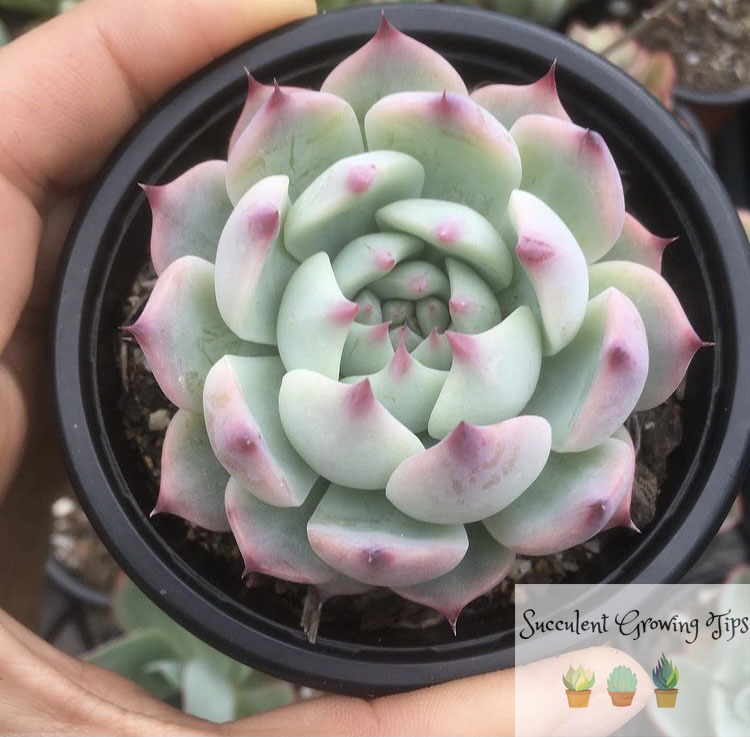Echeveria chihuahuensis is a beautiful succulent native to Mexico. It is both hardy and exceptionally pretty.
Below I will go through all there is to know about Echeveria chihuahuensis. The advice is based on growing thousands of these succulents in my nursery Fern Farm Plants.
Description
Echeveria chihuahuensis is a hardy and beautifully coloured evergreen succulent with a rosette type arrangement of leaves. The colour is usually blue-gray, but changes throughout the year. The tips are pink and when the plant is stressed and/or in winter, back of the leaves also turn pink-red.
A white, dusty coating of the protective farina covers all the leaves which are thick, short and pointy. They grow tightly together, if the plant is exposed to enough sunlight.
The rosettes of Echeveria chihuahuensis grow on a low stalk, close to the ground. Individual plants can reach approximately 15cm in diameter and 10cm height in ideal conditions.
Chihuahuensis forms clumps of rosettes. Once a rosette is mature, it will produce offsets at the bottom. Each offset will then go on to produce offsets of their own. This plant is, however, not extremely prolific in growing offsets and usually produces 2-3 every growing season.
Echeveria chihuahuensis flowers every spring. The blooms come up on a tall stalk where individual bell-shaped, pink flowers open. The inside of the flower is yellow.
Position & Care
Echeveria chihuahuensis is a hardy plant that can be grown outdoors all year round in moderate climates that do not experience any frost.
Unfortunately this plant is not frost hardy and so will need to be brought indoors during winter if frost or snow is expected. The plant will survive outdoors if the temperature does not fall below 1C/33F. Mild frost should not kill the chihuahuensis but it is likely to cause burns on the foliage.
The best appearance is achieved when chihuahuensis is grown in as much sun as possible. Having said that, in summer during heatwaves of over 35C/95F it is likely this plant will get burn-marks from strong UV rays and should be moved under cover/in shade/under 30% shade-cloth for the afternoon.
While Echeveria chihuahuensis will grow in a bright shade it is unlikely to produce those attractive pink tips and the rosette will not be very compact.
In pots, use succulent potting mix and for best results re-pot to a slightly bigger pot every growing season. This will help the plant to grow to its full size and produce offsets.
Echeveria chihuahuensis can also be grow in the garden and looks particularly fantastic in rockeries, succulent gardens or at the edges. Plants in the ground are usually a lot more hardy than those grown in pots. Mulch or pebbles can be used as well.
As long as succulent potting mix is used in pots, Echeveria chihuahuensis should not show any adverse signs to overwatering or too much rain. It is important the plant gets enough sun and that the pot has holes so the water does not clog the roots.
If the plant is in a greenhouse or undercover water once the potting mix dries up. In the ground, the chihuahuensis will not need to be watered all that often, though during heatwaves/drought it will thank you for a good soak every other day.
Echeveria chihuahuensis is not suitable to be grown indoors, other than for over-wintering. The only time this plant will have a chance at surviving inside is if it’s grown under plant growing lights or in a super bright sunroom.
Propagation
Echeveria chihuahuensis can be propagated by offsets, leaves and seeds. While propagating by offsets is the easiest method, leaves also have a good strike rate. As for seeds, while possible it can prove difficult to raise this plant from seed.
As mentioned above, Echeveria chihuahuensis will not grow loads of pups, but the ones that do pop out can easily be taken off and propagated. To read a more in-depth article on how to propagate succulent by offsets, go here.
It is quite easy to do leaf propagation with Echeveria chihuahuensis as it has a very high strike rate and a single leaf can produce as many as 3 or 4 rosettes. We have a detailed article on succulent leaf propagation here.
Seeds may not be a great idea for a number of reasons. One, it can be hard to find a reliable seed seller that will actually sell you seed that has not been contaminated with pollen of other succulents/ sell seeds that are viable. Two, germination of the seeds can also be unreliable and three, it can take a loooong time (years) for a seed to grow to a decent sized plant.
Whichever propagation method is used, Echeveria chihuahuensis should only be propagated in the growing season. This would be spring and summer, though do be careful that young plants do not get burned in strong summer sun.
Pests
Echeveria chihuahuensis is susceptible to all the usual succulent pests, but thankfully it is not one of the favourites. Aphids can attack the flowers, while the odd mealy bug can also burrow itself between the leaves, but if there are tastier plants around, they tend to leave chihuahuensis alone.
For a list of animals that like to eat succulents, you can read another one of our articles here.
Toxicity
As most Echeverias, Echeveria chihuahuensis is not toxic to humans, dogs, cats, other pets or livestock, though it is not recommended to consume this plant as food.
Where can I get it?
Echeveria chihuahuensis can be a little hard to get but specialist succulent nurseries/ online nurseries should stock this plant.
